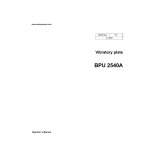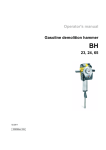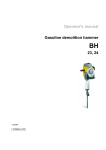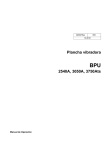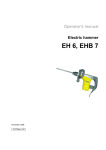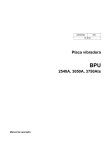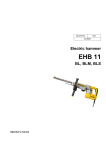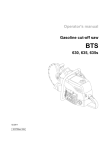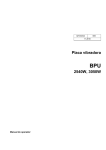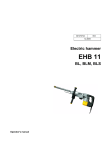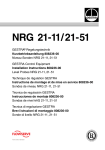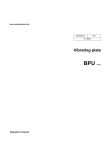Download Wacker Neuson BPU 3050A Operator`s manual
Transcript
0203079en 005 10.2010 Vibratory plate BPU 2540A, 3050A, 3750Ats Operator´s Manual Manufacturer Wacker Neuson SE Preußenstraße 41 80809 München www.wackerneuson.com Tel.: +49-(0)89-354 02-0 Fax: +49-(0)89-354 02-390 Translation of the original operator's manual in German 1 Foreword 1 Foreword This operator's manual contains information and procedures for the safe operation and maintenance of your Wacker Neuson machine. In the interest of your own safety and to prevent accidents, you should carefully read through the safety information, familiarize yourself with it and observe it at all times. This operator's manual is not a manual for extensive maintenance and repair work. Such work should be carried out by Wacker Neuson service or authorized specialists. The safety of the operator was one of the most important aspects taken into consideration when this machine was designed. Nevertheless, improper use or incorrect maintenance can pose a risk. Please operate and maintain your Wacker Neuson machine in accordance with the instructions in this operator's manual. Your reward will be troublefree operation and a high degree of availability. Defective machine parts must be replaced immediately! Please contact your Wacker Neuson representative if you have any questions concerning operation or maintenance. All rights reserved, especially reproduction and distribution rights. Copyright 2011 Wacker Neuson SE No part of this publication may be reproduced in any form or by any means, electronic or mechanical, including photocopying, without the expressed written permission of Wacker Neuson. Any type of reproduction, distribution or storage on data media of any type and form not authorized by Wacker Neuson represents an infringement of copyright and will be prosecuted. We expressly reserve the right to make technical modifications – even without special notice – which aim at further improving our machines or their safety standards. 3 TABLE OF CONTENTS DESCRIPTION 23 Description of function 23 TRANSPORT TO WORK SITE, RECOMMENDATIONS ON COMPACTION Transport to work site Recommendations on compaction 24 24 24 OPERATION 25 Engine check before starting Starting the engine Operation the engine Forward and reverse motion Stopping the engine 25 25 27 27 28 MAINTENANCE 29 Maintenance schedule Engine oil Hydraulic control Exciter Exciter V-belt Fuel strainer cup cleaning Spark plug Carburettor adjustment Air filter service 29 30 31 31 31 32 32 32 33 FAULTS 34 Reverse speed too low Forward speed too low No advance Loss of hydraulic oil Engine does not start 34 34 34 34 34 4 BPU 2 2.1 2 Safety Safety Principle State of the art This machine has been constructed with state-of-the-art technology according to the recognized rules of safety. Nevertheless, when used improperly, dangers to the life and limb of the operator or to third persons or damage to the machine or other materials cannot be excluded. Proper use The machine must only be used for the following purposes: Compaction of soils. Compaction of asphalt. Shaking in of paving stones. The machine may not be used for the following purposes: Compaction of intensely cohesive soils. Compaction of frozen soils. Compaction of hard, non-compactable soils. Compaction of soils that are not capable of bearing a load. Its proper use also includes the observance of all instructions contained in this operator's manual as well as complying with the required service and maintenance instructions. Any other use is regarded as improper. Any damage resulting from improper use will void the warranty and the liability on behalf of the manufacturer. The operator assumes full responsibility. Structural modifications Never attempt to modify the machine without the written permission of the manufacturer. To do so will endanger your safety and the safety of other people! In addition, this will void the warranty and the liability on behalf of the manufacturer. Especially the following are cases of structural modifications: Opening the machine and the permanent removal of components from Wacker Neuson. Installing new components which are not from Wacker Neuson and not equivalent to the original parts in design and quality. Installation of accessories which are not from Wacker Neuson. It is no problem to install spare parts from Wacker Neuson. It is no problem to install accessories that are available in the Wacker Neuson product range of your machine. Please refer to the installation regulations in this operator's manual. Operator's manual 5 2 Safety BPU Requirements for operation The ability to operate the machine safely requires: Proper transport, storage and setup. Careful operation. Careful service and maintenance. Operation Operate the machine only as intended and only when in proper working condition. Operate the machine in a safety-conscious manner with all safety devices attached and enabled. Do not modify or disable any safety devices. Before starting operation, check that all control and safety devices are functioning properly. Never operate the machine in a potentially explosive environment. Supervision Never leave the machine running unattended! Maintenance Regular maintenance work is required in order for the machine to operate properly and reliably over time. Failure to perform adequate maintenance reduces the safety of the machine. Strictly observe the prescribed maintenance intervals. Do not use the machine if it requires maintenance or repairs. Malfunctions If you detect a malfunction, you must shut down and secure the machine immediately. Eliminate the malfunctions that impair safety immediately! Have damaged or defective components replaced immediately! For further information, refer to chapter Troubleshooting. Spare parts, accessories Use only spare parts from Wacker Neuson or such that are equivalent to the original parts in design and quality. Only use accessories from Wacker Neuson. Non-compliance will exempt the manufacturer from all liability. 6 Operator's manual BPU 2 Safety Exclusion of liability Wacker Neuson will refuse to accept liability for injuries to persons or for damage to materials in the following cases: Structural modifications. Improper use. Failure to comply with this operator's manual. Improper handling. Using of spare parts which are not from Wacker Neuson and not equivalent to the original parts in design and quality. Using of accessories which are not from Wacker Neuson. Operator's manual Always keep the operator's manual near the machine or near the worksite for quick reference. If you have misplaced the operator's manual or require an additional copy, contact your Wacker Neuson representative or download the operator's manual from the Internet (www.wackerneuson.com). Always hand over this operator's manual to other operators or to the future owner of the machine. Country-specific regulations Observe the country-specific regulations, standards and guidelines in reference to accident prevention and environmental safety, for example those pertaining to hazardous materials and wearing protective gear. Complement the operator's manual with additional instructions taking into account the operational, regulatory, national or generally applicable safety guidelines. Operator's controls Always keep the operator's controls of the machine dry, clean and free of oil or grease. Operating elements such as ON/OFF switch, gas handles etc. may not be locked, manipulated or changed without authorization. Cleaning Always keep the machine clean and be sure to clean it each time you have finished using it. Do not use gasoline or solvents. Danger of explosion! Do not use high pressure washers. Permeating water can damage the machine. When electrical equipment is present, this can pose a serious injury risk from electric shocks. Operator's manual 7 2 Safety BPU Checking for signs of damage Inspect the machine when it is switched off for any signs of damage at least once per work shift. Do not operate the machine if there is visible damage or defects. Have any damage or defects eliminated immediately. 2.2 Qualification of the operating personnel Operator qualifications Only trained personnel are permitted to start and operate the machine. The following rules also apply: You are at least 18 years of age. You are physically and mentally fit. You have received instruction on how to independently operate the machine. You have received instruction in the proper use of the machine. You are familiar with required safety devices. You are authorized to start machines and systems in accordance with the standards governing safety. Your company or the operator has assigned you to work independently with this machine. Incorrect operation Incorrect operation or misuse by untrained personnel can endanger the health and safety of the operator or third persons and also cause machine and material damage. Operating company responsibilities The operating company must make the operator's manual available to the operator and ensure that the operator has read and understood it. Work recommendations Please observe the recommendations below: 8 Work only if you are in a good physical condition. Work attentively, particularly as you finish. Do not operate the machine when you are tired. Carry out all work calmly, circumspectly and carefully. Never operate the machine under the influence of alcohol, drugs or medication. This can impair your vision, reactions and your judgment. Work in a manner that does not endanger others. Ensure that no persons or animals are within the danger zone. Operator's manual BPU 2.3 2 Safety Protective gear Work clothing Clothing should be appropriate, i.e. should be close-fitting but not restrict your movement. When on construction sites, do not wear long hair loosely, loose clothing or jewelry including rings. These objects can easily get caught or be drawn in by moving machine parts. Only wear clothing made of material that is not easily flammable. Personal protective gear Wear personal protective gear to avoid injuries or health hazards: Non-skid, hard-toed shoes. Work gloves made of durable material. Overalls made of durable material. Hard hat. Ear protection. Ear protection This machine generates noise that exceeds the country-specific permissible noise levels (individual rating level). It may therefore be necessary to wear ear protection. You can find the exact value in the chapter Technical Data. When wearing ear protection while working, you must pay attention and exercise caution because your hearing is limited, e.g. in case someone screams or a signal tone sounds. Wacker Neuson recommends that you always wear ear protection. 2.4 Transport Switching off the machine Before you transport the machine, it must be switched off, and the engine must be given sufficient time to cool down. Center pole in transport position Before commencing transport, move the center pole to the transport position. Let the center pole latch into its lock. Observing hazardous materials regulations Observe the national safety guidelines and the hazardous materials regulations that apply to the respective means of transportation. Operator's manual 9 2 Safety BPU Lifting When lifting the machine, observe the following instructions: Designate a skilled person to guide you for the lifting procedure. You must be able to see or hear this person. Use only suitable and certified hoisting gear, lifting tackle and load-bearing equipment with sufficient lifting capacities. Only use the attachment points described in the operator's manual. Attach the machine securely to the hoisting gear. Ensure that no one is nearby or under the machine. Do not climb onto the machine. Loading the machine Loading ramps must be able to bear the load and be in a stable position. Make sure that no one can be endangered if the machine slips away or tips over or if machine parts suddenly move upward or downward. Put the operating controls and moving parts in their transport position. Secure the machine with load-securing straps so that it cannot tip over, fall down or slide away. Only use the attachment points described in the operator's manual. Transport vehicle Use only suitable transport vehicles with sufficient load-carrying capacity and suitable tie-down lugs. Transporting the machine Secure the machine on the transport device against tilting, falling or slipping. Only use the lashing points listed in the operating instructions. Also observe the country-specific regulations, standards and guidelines. Restarting Machines, machine parts, accessories or tools that were detached for transport purposes must be re-mounted and fastened before restarting. Only operate in accordance with the operating instructions. 2.5 Operating safety Explosible environment Never operate the machine in a potentially explosive environment. 10 Operator's manual BPU 2 Safety Work environment Familiarize yourself with your work environment before you start work. This includes e.g. the following items: Obstacles in the work and traffic area. Load-bearing capacity of the ground. The measures needed to cordon off the construction site from public traffic in particular. The measures needed to secure walls and ceilings. Options available in the event of an accident. Safety in the work area When working with the machine especially pay attention to the following points: Electric lines or pipes in work area. Gas lines or water lines in the work area. Starting the machine Observe the safety information and warning notices located on the machine and in the operator's manual. Never attempt to start a machine that requires maintenance or repairs. Start the machine as directed in the operator's manual. Vertical stability Always ensure that the machine is vertically stable and cannot tip over, roll or slide away. Proper operator position Do not leave the proper operator position while operating the machine. The proper operator position is behind the center pole of the machine. Leaving the danger area Injury may be caused by moving machines or flying materials. Ensure that other persons observe a minimum safety distance of 2 m from the machine. Caution with movable parts Keep your hands, feet and loose clothing away from moving or rotating machine parts. Parts of your body being pulled in or crushed can cause serious injuries. Operator's manual 11 2 Safety BPU Switching off the machine Switch off the engine in the following situations: Before breaks. If you are not using the machine. Store the machine in such a way that it cannot tilt, fall or slip. Storage location After operation, allow the machine to cool and then store it in a sealed-off, clean and dry location protected against frost and inaccessible to children. Not using starter sprays Highly flammable starter sprays pose a fire hazard. Do not use any starter sprays. Starter sprays are highly flammable and can cause backfiring and engine damage. Vibrations When manually operated machines are intensively used, long-term damage caused by vibrations cannot be precluded. Observe the relevant legal instructions and guidelines to minimize vibration stress. Details on vibration stress associated with the machine can be found in the chapter Technical Data. 2.6 Safety during the operation of vibratory plates Integrated driving mechanism Machines with integrated driving mechanism must not be set down or stored on the transport device. The driving mechanism is only intended for transport. Belt guard Never operate the machine without a belt guard! Exposed belts and belt pulleys are dangerous and can cause serious injuries if they pull in any part of your body or if parts are ejected. Danger of falling over Operate the machine so that it cannot tip over or fall down from bordered areas, edges and steps. Load-carrying capacity of the ground Keep in mind that the load-carrying capacity of the earth to be compressed or bed can be greatly reduced by the effects of vibration, for example near slopes. 12 Operator's manual BPU 2 Safety Avoiding crushing When operating the machine, pay particular attention to avoid being squeezed between the machine and an obstacle. Always look in the direction of travel! Compacting on slopes The following points must be observed if you plan to compact inclined surfaces (slopes, escarpments): Always stand above the machine on a slope. Start at the bottom of a slope (slopes that can be easily managed in an upward direction can be safely traveled in a downward direction also). Never stand in a position where the machine could possibly fall. A slipping or tipping machine can cause serious injuries. Not exceeding the maximum tilt position Do not exceed the maximum tilt position (see chapter Technical Data). Only operate the machine at maximum tilt for short periods of time. If you exceed the maximum tilt, the engine lubrication system will fail and thus inevitably damage important engine parts. Check the effects of vibration Compacting work in the vicinity of buildings can lead to structural damage. For this reason you must always check the possible effects of vibrations on surrounding buildings in the run-up to work. You must take the following points into special consideration when evaluating the effects of vibration: Vibration behavior, sensitivity and resonance frequency of surrounding buildings. Distance of the buildings from the vibrationsite (= worksite). Condition of the soil. You may need to carry out measurements to determine the vibration speed. You must also comply with the relevant guidelines and regulations, particularly DIN 4150-3. The foundation must also have sufficient load-bearing capacity to withstand the compaction energy. In case of doubt involve a soil mechanics specialist in the evaluation. Wacker Neuson is not liable for any structural damage. Operator's manual 13 2 Safety 2.7 BPU Safety during the operation of combustion engines Checking for signs of damage Check the engine while switched off for leaks and cracks in the fuel line, tank and fuel cap at least once per work shift. Do not operate the machine if there is visible damage or defects. Have any damage or defects eliminated immediately. Dangers during operation Combustion engines can be dangerous, particularly during operation and when refueling. Read and follow all safety instructions. Otherwise there is a risk of personal injury and/or damage to property! Do not start the engine near spilt fuel or if you smell fuel – this may cause an explosion! Remove the machine from such areas. Remove the spilt fuel immediately! Not changing the engine speed Do not change the preset engine speed, as this may cause engine damage. Preventing fires Open flames and smoking are strictly prohibited in the immediate vicinity of the machine. Make sure that waste, such as paper, dry leaves or grass do not accumulate around the exhaust muffler. The waste materials may ignite. 14 Operator's manual BPU 2 Safety Safety precautions when refueling Please observe the following safety-relevant instructions when refueling: Do not refuel near open flames. Do not smoke. Turn off the engine before refueling and allow it to cool down. Refuel in a well-ventilated environment. Wear fuel-proof protective gloves and, if there is the possibility of spraying, protective goggles and clothing. Do not inhale fuel vapors. Avoid skin and eye contact with fuel. For refueling, use clean tools such as a hopper. Do not spill fuel, especially onto hot parts. Remove any spilt fuel immediately. Use the correct fuel grade. Do not mix fuel with other liquids. Fill the tank only up to the maximum marking. If there is no Maximum marking, do not fill up the tank completely. Lock the fuel cap securely after refueling. Operation in closed rooms In closed or partially closed rooms such as tunnels, drifts or deep trenches, ensure sufficient ventilation and extraction by, for example, providing a powerful exhaust air fan. Danger of poisoning! Do not inhale exhaust fumes. They contain toxic carbon monoxide that can lead to unconsciousness or death. Caution with hot parts Do not touch any hot parts such as the engine block or exhaust muffler during operation or directly afterwards. These parts can become very hot and cause severe burns. Shutting off the fuel tap When the machine stops, shut off the fuel tap. Cleaning the engine Clean the engine when it is cool to remove any dirt. Do not use gasoline or solvents. Danger of explosion! Operator's manual 15 2 Safety BPU Notes on the EPA engine Caution This machine is equipped with an EPA-certified engine. Modifying the motor speed influences the EPA certification and emission. The motor may only be set by a skilled technician. For more detailed information, contact your nearest motor or Wacker Neuson representative. Health hazard due to exhaust fumes Warning The engine's exhaust fumes contain chemicals which are known to the State of California to cause cancer, congenital defects or other reproductive anomalies. 2.8 Safety during the operation of hydraulic machines Hydraulic oil Hydraulic oil is harmful to health. Wear safety glasses and safety gloves when handling hydraulic oil. Avoid direct skin contact with hydraulic oil. Remove hydraulic oil from the skin immediately with soap and water. Make sure that no hydraulic oil comes gets in the eyes or on the body. See a physician immediately if hydraulic oil gets into the eyes or is swallowed. Do not eat and drink while handling hydraulic oil. Make sure to have extreme cleanliness. Contamination of the hydraulic oil with dirt or water can cause premature wear or failure of the machine. Dispose of left over and spilled hydraulic oil according to the applicable regulations for environmental protection. 2.9 Maintenance Maintenance work Service and maintenance work must only be carried out to the extent described in these operating instructions. All other procedures must be performed by your Wacker Neuson representative. For further information, refer to chapter Maintenance. Switching off the engine Before carrying out care or maintenance work, switch off the engine and allow it to cool down. For gasoline powered engines, you must pull off the spark plug cap. 16 Operator's manual BPU 2 Safety Assembling safety devices If it was necessary to dismantle safety devices, they must be reassembled and checked immediately after completing maintenance work. Always tighten loosened screw connections, complying with prescribed starting torque. Handling operating fluids safely Observe the following points when handling operating fluids, e.g. fuels, oils, greases, coolants etc.: Always wear personal safety clothing. Avoid skin and eye contact with operating fluids. Do not inhale or swallow operating fluids. In particular, avoid contact with hot operating fluids. Burn and scalding hazard. Dispose of replaced or spilled operating fluids according to the applicable regulations for environmental protection. If operating fluids escape from the machine, cease operation of the machine and have it repaired immediately by your Wacker Neuson representative. Operator's manual 17 2 Safety 2.10 BPU Safety and information labels Your machine has adhesive labels containing the most important instructions and safety information. Make sure that all the labels are kept legible. Replace any missing or illegible labels. The item numbers for the labels are in the parts book. Item Label Description 0219260 1 0219175 2 18 Wear personal protective gear to avoid injuries or health hazards: Ear protection. Read the operator's manual before startup. Start-Stop. 0219259 3 If the machine falls, it can cause severe crushing injuries. f Only lift the machine with certified hoist and lifting tackle (safety load hook). f Do not lift the machine with the excavator shovel by the central suspension. Operator's manual BPU 2 Safety Item Label Description 4 Improper handling can cause serious damage to the engine. f When using the integrated wheels, always turn off the engine. If the engine is running, engine lubrication cannot be ensured in the transport position. There is also a danger that oil may leak out of the engine crankcase breather. 5 If the machine falls, it can cause severe crushing injuries. f Do not lift the machine by the guide handle or the center pole. 0220000 6 Guaranteed sound power level. 7 Danger of fire. Smoking and open flames are prohibited. 0219181 8 9 Warning of hot surface. US machines Warning. WARNING WARNUNG ADVERTENCIA 0219261 ADVERTISSEMENT 0219176 10 US machines Caution. CAUTION VORSICHT ATENCIÓN ATTENTION 0219262 11 US machines Danger. DANGER GEFAHR 0218955PELIGRO DANGER0219178 Operator's manual 19 3 Technical data 3 Technical data Machine Designation Unit Item no. * BPU 2540A BPU 3050A BPU 3750Ats 0008758 0610360 0008763 0610361 0610408 0610423 Length x width x height (guide handle in transport position) mm (ft) 733,5 x 400 x 1163 (2.4 x 1.3 x 3.8) Operating weight kg (lb) 145 (320) Advance and reverse travel m/min (ft/min) Area capacity m²/h (ft²/h) Maximum permissible tilt ° Sound pressure level L pA at operator's station * dB(A) 89 93 95 Measured sound power level LWA dB(A) 102 105 107 Guaranteed sound power level LWA dB(A) Total vibration value of the acceleration ahv** m/s2 (ft/ s2) Uncertainty of measurement of the vibration total value of the acceleration ahv m/s2 (ft/ s2) 166 (366) 21 (69) 504 (5425) 240 (529) 25 (82) 630 (6781) 750 (8073) 20 108 1,9 (6.2) According to DIN EN ISO 11201 ** Determined according to DIN EN ISO 5349. 20 733,5 x 500 x 1175 (2.4 x 1.6 x 3.8) 2,8 (9.2) 1,0 (3.2) 1,5 (4.9) 3 Technical data Drive motor Designation Unit BPU 2540A BPU 3050A Manufacturer Honda Type GX160 GX270 Combustion method 4-cycle Engine type Gasoline engine Cooling Engine displacement Air cooling cm³ (in³) 163 (9.9) Cylinder 270 (16.5) 1 Rated output* kW Engine speed rpm Fuel type 3,1 5,2 2,800 Regular gasolino, lead-free (>86 oktane) Fuel consumption l/h (qt/h) 0,8 (0,84) 1,1 (1,16) Tank capacity l (qt) 3,1 (3.27) 5,3 (5,60) Fuchs Titan Unic 10W40 MC (SAE 10W40) Oil specification Oil quantity max. l (qt) 0,6 (0,63) 1,1 (1,16) Oil quantity min. l (qt) 0,5 (0,53) 0,9 (0,95) Spark plug Spark plug air gap * BPU 3750ATS BPR6ES (NGK), W20EPR-U (ND) mm (in) 0,7-0,8 (0.027-0.031) Equivalent to the installed power output in accordance with the directive 2000/14/EC. 21 3 Technical data Exciter Designation Unit Vibrations rpm (Hz) Centrifugal force kN Oil specification Oil quantity BPU 2540A BPU 3050A BPU 3750ATS 5,400 (90) 25 30 37 Fuchs Titan Unic 10W40 MC (SAE 10W40) l (qt) 0.6 (0.63) Hydraulic Designation Unit 22 BPU 3050A BPU 3750ATS Fuchs Renolin MR 520 Oil specification Oil quantity BPU 2540A l (qt) 0,4 (0.42) DESCRIPTION Description of function The vibration required for compaction is produced by the exciter (5) which is firmly joinded to the lower mass (4). This exciter (5) is designed as a central vibrator with aligned vibrations. Such a principle permits the direction of vibration to be changed by turning the eccentric weights (13). In this way an infinitely variable transition between vibration in forward motion, at standstill and in reverse motion is possible. This process is hydraulically controlled with the operating control handle (7) on the centre pole head (8). Forwards On the spot Reverse The drive engine (1) is anchored to the upper mass (3) and drives the exciter (5). The torque is transmitted by means of a friction connection through the centrifugal clutch (9) and the exciter V-belt (10). The centrifugal clutch (9) interrupts the power transmission to the exciter (5) at low engine turning speed, thus allowing for a perfect idling speed of the drive engine (1). The turning speed of the engine (1) can be infinitely adjusted by way of the throttle lever (6). The upper (3) and lower (4) masses are connected to each other by 4 vibration-damping shock mounts (11). This damping system prevents the very high frequencies from being transmitted to the upper mass (3). As a result the functionability of the drive engine (1) is retained in spite of the high compaction performance. he drive engine (1) works according to the 4-stroke principle, is started by way of a recoil starter, sucks in combustion air over a dry air filter (12) and is air-cooled. To facilitate the starting procedure the drive engine (1) has an decompression mechanism. T00845GB.fm 23 TRANSPORT TO WORK SITE, RECOMMENDATIONS ON COMPACTION Transport to work site Conditions: - To transport the vibration plate, use only suitable lifting equipment with a minimum load-bearing capacity of 250 kg. - Only attach suitable tackle at the central lifting point (15) provided. - Always tie down the vibratory plate by the protective frame (14) and latch the center pole in place during transport of the vibratory plate on the loading area of a transport vehicle. ATTENTION! The engine must be stopped when using the integrated transport device. Lubrication of the engine is not guaranteed if the engine is running when the plate is in transport position. This could lead to serious engine damages. Furthermore the danger exists that oil will spill out of the crankcase breather. Note: Also observe the regulations in the chapter “Safety instructions“. Recommendations on compaction Ground conditions The max. compaction depth depends on several factors relating to the ground condition, such as moisture, grain distribution etc. It is therefore not possible to specify exact values. Recommendation: In each case determine the max. compaction depth with compaction tests and soil samples. Compaction on slopes The following points are to be observed when compacting on sloped surfaces (slopes, embankments): * Only approach gradients from the bottom (a gradient which can be easily overcome upwards, can also be compacted downwards without any risk). * The operator must never stand in the direction of descent (see chapter “Safety instructions“). * The max. gradient of 20o must not be exceeded. ATTENTION! If this gradient were exceeded, this would result in a failure of the engine lubrication system (splash lubrication) and thus inevitably lead to a breakdown of important engine components. Wrong ! T00846GB.fm Right ! 24 OPERATION Engine check before starting 1. Oil level check Insert dipstick in oil filler neck, but without screwing in. If oil level is low, fill to the top of the oil filler neck with high grade Fuchs Titan Unic 10W40 MC oil. ATTENTION! Place machine in horizontal position before checking engine oil level. 2. Dual-air cleander >Dual element type< Check the air cleaner elements to be sure they are clean and in good condition. Clean or replace the elements if necessary. 3. Fuel Use any regular grade automotive gasoline (unleaded gasoline is preferred) with a pump octane rating of 86 or higher. Never use an oil/gasoline mixture or dirty gasoline: Avoid getting dirt, dust or water in the fuel tank. Caution: Gasoline substitutes are not recommended, they may be harmful to the fuel system components. Starting the engine 1. Move the fuel shut-off valve (lever in arrow direction) to the „ON“ position. 2. Move the choke lever to the CLOSE position. Note: If the engine is warm or the air temperature is high, move the control lever away from the CHOKE postion as soon as the engine starts. T00847GB.fm 25 OPERATION 3. Pull the throttle lever (6) back slightly. 4. Turn the engine switch to the „I“ position. 5. Pull the starter grip lightly until resistance is felt, then pull briskly. Caution: T00847GB.fm Do not allow the starter grip to snap back against the engine. Return it gently to prevent damage to the starter. 26 OPERATION Operation the engine As the engine warms up, gradually move the choke lever to the OPEN position. Position the throttle lever for the desired engine speed. Oil alert system The oil alert system is designed to prevent engine damage caused by an insufficient amount of oil in the crankcase. Before the oil level in the crankcase drops below a safe limit, the oil alert system will automatically shut down the engine (the engine switch will remain in the „I“ position). Note: If engine does not start check oil level Forward and reverse motion The engine speed can be infinitely varied with the throttle control lever (6). The direction of travel is determined with the operating control handle (7). Depending on the position of the control handle (7), the vibration plate compacts in forward direction, on the spot or in reverse direction. Forwards T00847GB.fm On the spot 27 Reverse OPERATION Stopping the engine To stop the engine in an emergency, turn the engine switch to the „0“ position. Under normal conditions, use the following procedure: 1. Push the throttle lever forward all the way to the stop. 2. Turn the ignition switch to the „0“ position. 3. Turn off the fuel shut-off valve (lever in arrow direction). T00847GB.fm 28 MAINTENANCE Maintenance schedule Parts Maintenance jobs Maintenance interval Air filter daily Fuel tank Engine oil Exciter Bowden cable Check for external damage and tight fit. Check filter cartridge, clean or replace if necessary. Check tank lid for tight fit, replace if necessary. Check oil level, top up if necessary. Check for tightness. Check to see smooth running. Engine oil First oil change. after 20 hours Ignition system Exciter Hydraulic control V-belt Protective frame Clean spark plug, check spark plug gap 0,7 mm. Check attachment screws for tight fit. Check oil level, top up if necessary. Check V-belt tension-retension, if need be. Check fastening screws of protective frame and central suspension for tight fit. monthly Engine oil Exhaust muffler Further oil changes. Remove combustion residue from spark arrester. after 100 hours Exciter Check oil level-fill up, if need be. after 150 hours Exciter Oil change. after 250 hours Valve clearance Check, set - 0,15 mm intake valve, 0,20 mm exhaust valve. after 300 hours T00848GB.fm 29 MAINTENANCE Engine oil Check oil level: The engine must be horizontally place when filling in oil or checking the oil level. Check oil level with dip stick (16). If oil level is to low, top up with brand quality oil Fuchs Titan Unic 10W40 MC through oil feed opening (16). Oil change: Drain the oil while the engine is still warm to assure rapid and complete draining. 1. Remove the oil filler cap (16). 2. Release the waist oil drain hose (2) and collect the draining oil in an appropriate container. 3. Attach the waist oil drain hose (2) back again. 4. Pour the recommended oil through the oil filler tube (16) and then check the oil level. ATTENTION! Place machine in horizontal position before checking engine oil level. 5. Install the oil filter cap. Take notice: T00848GB.fm Please pay attention to the corresponding environmental laws when disposing of used engine oil. We recommend you carry the oil in a container to a central collecting point for used oils. Do not pour used engine oil into the garbage nor into the sewer system, waste pipes or even on the ground. 30 MAINTENANCE Hydraulic control Check oil level: 1. Move centre pole into vertical position. 2. Push operating control handle (7) to forward travel position. 3. Open filler bore (17). 4. The oil level must reach the upper edge Oil of the gear; add Fuchs Renolin MR 520 hydraulic fluid if required. 5. Close filler bore (17). Hydraulic control system is self-bleeding. Exciter Check oil level: 1. Position vibration plate horizontally. 2. Open filler bore (19). 3. The oil level must reach the start of the thread (19) of the filler bore. 4. If necessary, pour in brand oil Fuchs Titan Unic 10W40 MC through filler bore (use funnel). 5. Close filler bore (19). Changing the oil: 1. Open filler bore (19). 2. Tilt vibration plate and keep it tilted until the oil has run out. 3. Place vibration plate in horizontal position. 4. Pour in brand oil Fuchs Titan Unic 10W40 MC through the filler bore (19). 5. Close filler bore (19). ATTENTION! Do not pour in too much oil! Exciter V-belt Remove belt guard. Remove the screws from the engine’s V-belt pulley and then pull off the V-belt pulley half. Take out the necessary number of discs (removal of one disc is usually enough). Place the discs just removed on the outside of the V-belt pulley half. Turn in the screws by hand and then alternately tighten while constantly turning the engine’s V-belt pulley. Run the machine a few moments and then retighten the screws if necessary. T00848GB.fm 31 MAINTENANCE Fuel strainer cup cleaning Turn the fuel valve to Off. Remove the sediment cup and O-ring, and wash them in nonflammable or high flash point solvent. Dry them thoroughly, and reinstall securely. Turn the fuel valve on, and check for leaks. Spark plug Caution: Never use a spark plug of incorrect heat range. To ensure proper engine operation, the spark plug must be properly gapped and free of deposits. 1. Remove the spark plug cap, and use a spark plug wrench to remove the plug. Warning: If the engine has been running, the muffler will be very hot. Be careful not to touch the muffler. 2. Visually inspect the spark plug. Discard it if the insulator is cracked or chipped. Clean the spark plug with a wire brush if it is to be reused. 3. Measure the plug gap with a feeler gauge. The gap should be 0,7-0,8 mm (0.039-0.043 in). Correct as necessary by bending the side electrode. 4. Check that the spark plug washer is in good condition, and thread the spark plug in by hand to prevent cross-threading. 5. After the spark plug is seated, tighten with a spark plug wrench to compress the washer. Note: Caution: If installing a new spark plug, tighten 1/2 turn after the spark plug seats to compress the washer. If reinstalling a used spark plug, tighten 1/8-1/4 turn after the spark plug seats to compress the washer. The spark plug must be securely tightened. An improperly tightened spark plug can become very hot and may damage the engine. Carburettor adjustment * * Start the engine and allow it to warm up to normal operting temperature. With the engine idling, turn the pilot screw in or out to the setting that produces the highest idle rpm. The correct setting will usually be approximately 2 1/4 turns from the fully closed position. Caution: Do not tighten the pilot screw against its seat as this will damage the pilot screw or seat. After the pilot screw is correctly adjusted, turn the throttle stop screw to obtain the standard idle speed. Standard idle speed: 1 400 + 150 rpm. 1. Pilot screw T00848GB.fm 2. Throttle stop screw 32 MAINTENANCE Air filter service A dirty air filter will restrict air flow to the carburettor. To prevent carburettor malfunction, service the air filter regularly. Service more freqently when operating the engine in extremely dusty areas. Warning: Never use gasoline or low flash point solvents for cleaning the air cleaner element. A fire or explosion could result. Caution: Never run the engine without the air cleaner. Rapid engine wear will result. 1. Remove the wing nut and the air filter cover. Remove the elements and separate them. Carefully check both elements for holes or tears and replace if damaged. 2. Foam element: Wash the element in a solution of household detergent and warm water, then rinse thoroughly, or wash in nonflammable or high flash point solvent. Allow the element to dry thoroughly. Soak the element in clean engine oil, and squeeze out the excess oil. The engine will smoke during initial start-up if too much oil is left in the foam. 3. Paper element: Tap the element lightly serveral times on a hard surface to remove excess dirt, or blow compressed air through the filter from the inside out. Never try to brush the dirt off; brushing will force dirt into the fibers. Replace the paper element if it is excessively dirt. T00848GB.fm 33 FAULTS Reverse speed too low Cause: Remedy: - Too little hydraulic oil in the centre pole head. Air in hydraulic control. Top up hydraulic oil. Bleed system. Forward speed too low Cause: - Too much oil in centre pole head. Remedy: - Correct oil level in accordance with mark. No advance Cause: - Mechanical fault. Remedy: - Contact Wacker service dept. Loss of hydraulic oil Cause: - Leaks, hydraulic hose defective. Remedy: - Change defective parts. Note: Bleed system after every dismantling operation. Engine does not start Cause: - Fuel tank empty. - Fuel shut-off valve closed. - Air filter dirty. - Stop button defective. - Recoil starter defective. - Oil alert system has stopped engine. Remedy: - Fuel up. - Open. - Clean. - Repair. - Repair. - Fill up with engine oil. T00849GB.fm 34 4 Emission control systems information and warranty 4 Emission control systems information and warranty The Emission Control Warranty and associated information is valid only for the U.S.A., its territories, and Canada. Emission control systems warranty statement See the engine owner’s manual for the applicable exhaust and evaporative emission warranty statement. Operator´s manual 35 5 Glossary 5 5.1 Glossary Use of oxygenated fuels Some conventional gasolines are blended with alcohol. These gasolines are collectively referred to as oxygenated fuels. If you use an oxygenated fuel, be sure it is unleaded and meets the minimum octane rating requirement. Before using an oxygenated fuel, confirm the fuel's contents. Some states / Provinces require this information to be posted on the fuel pump. The following are Wacker Neuson approved percentages of oxygenates: Ethanol - (ethyl or grain alcohol) 10% by volume. You may use gasoline containing up to 10% ethanol by volume (commonly referred to as E10). Gasoline containing more than 10% ethanol (such as E15, E20, or E85) may not be used because it could damage the engine. Methanol - (methyl or wood alcohol) 5% by volume. You may use gasoline containing up to 5% methanol by volume, as long as it contains cosolvents and corrosion inhibitors to protect the fuel system. Gasoline containing more than 5% methanol by volume may cause starting and/or performance problems. It may also damage metal, rubber, and plastic parts of your fuel system. If you notice any undesirable operating symptoms, try another service station, or switch to another brand of gasoline. Fuel system damage or performance problems resulting from the use of an oxygenated fuel containing more than the percentages of oxygenates mentioned above are not covered under warranty. 36 EC Declaration of Conformity Manufacturer Wacker Neuson SE Preußenstraße 41, 80809 München Product Type BPU 2540A Product type BPU 3050A BPU 3750Ats Vibrating plate Item no. 0008758 Installed power output kW 3,1 Measured sound power level dB(A) 102 Guaranteed sound power level dB(A) 0008763 0610408 5,2 105 107 108 Conformity assessment procedure acc. to 2000/14/EC, Appendix VIII, 2005/88/EC at following test center: VDE Prüf- und Zertifizierungsinstitut GmbH, Merianstraße 28, 63069 Offenbach/Main Guidelines and standards This is to certify that this product meets and complies with the relevant regulations and requirements of the following guidelines and standards: 2006/42/EC, 2000/14/EC, 2005/88/EC, 2004/108/EC, EN 55012:2007 Authorized person for technical documents: Axel Häret Munich, 30.08.2010 Franz Beierlein Head of product management Dr. Michael Fischer Head of Research and Development www.wackerneuson.com








































